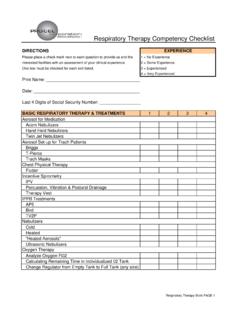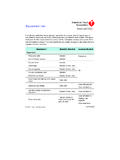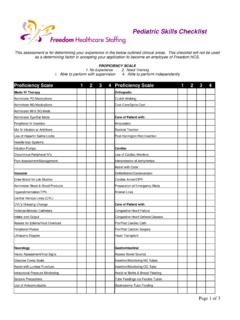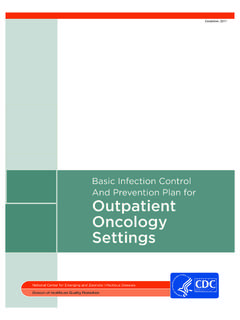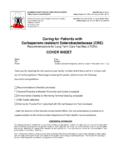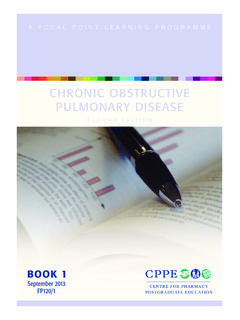Transcription of TABLE OF CONTENTS - alfredicu.org.au
1 GUIDELINE Extracorporeal Membrane Oxygenation (ECMO) Prompt Doc No: <#doc_num> v<#ver_num> Approval Date: Nov 2012 Review & Update by: Nov 2015 Page 1 of 64 The hard copy of this document may be out of date. To ensure you are reading the current version, check the policy and guideline site on the Alfred Health Intranet. TARGET AUDIENCE Staff involved in management of patients receiving Extracorporeal Membrane Oxygenation (ECMO) in ICU PURPOSE This document describes the standardised management of patients receiving ECMO in ICU. TABLE OF CONTENTS TARGET AUDIENCE .. 1 PURPOSE .. 1 2 1. Application of this Protocol and Related Documents .. 2 2. Equipment referred to in this Protocol .. 2 3. ECMO Definitions .. 2 4. ECMO Modes .. 5 5. VV ECMO Configurations.
2 7 6. VA ECMO Configurations .. 11 7. Patient Selection .. 16 8. Clinical Triggers for ECMO .. 17 9. ECMO Referral Pathway (including Inter- and Intra-Hospital Transport) .. 18 10. Circuit Priming of PLS and HLS circuits .. 19 11. ECMO Initiation .. 19 12. ECMO Related Clinical Duties (Commencement to Weaning) .. 24 13. ECMO Specific Routine Nursing Care .. 24 14. ECMO Specific Routine Medical Care .. 28 15. Prevention of complications .. 31 16. Troubleshooting .. 32 17. Conversion to Hi-Flow ECMO .. 35 18. Intra-hospital Transport .. 35 19. Weaning of ECMO support .. 36 20. Cannula Removal and Circuit Disposal .. 36 21. Equipment Maintenance and management .. 37 Emergency responses: VA ECMO .. 38 Emergency responses: VV ECMO .. 44 KEY RELATED DOCUMENTS .. 49 REFERENCES .. 49 AUTHOR / CONTRIBUTORS.
3 49 Appendix 1: Inclusion and Exclusion criteria for ECMO 2012 .. 50 Appendix 2: ECMO referral pathway .. 51 Appendix 3: Equipment List for retrieval .. 52 Appendix 4: ICU ECMO trolley equipment check list .. 54 Appendix 5: PLS Nursing start of shift ECMO check List .. 56 Appendix 6: Cardiohelp (HLS) Checklist checklist .. 57 Appendix 7: ECMO Daily orders and Hourly observation stickers .. 58 Appendix 8: VV Flowchart .. 59 Appendix 9: VA Flowchart .. 60 Appendix 10: Prevention of complications summary .. 61 Appendix 11: ICU VA ECMO Weaning 62 Appendix 12: ECMO retrieval cannulation requirements of referring centres .. 63 Appendix 13: ICU ECMO Cannulation Trolley Equipment Check List .. 64 GUIDELINE Extracorporeal Membrane Oxygenation (ECMO) Prompt Doc No: <#doc_num> v<#ver_num> Approval Date: Nov 2012 Review & Update by: Nov 2015 Page 2 of 64 The hard copy of this document may be out of date.
4 To ensure you are reading the current version, check the policy and guideline site on the Alfred Health Intranet. GUIDELINE 1. Application of this Protocol and Related Documents This protocol provides guidelines for the safe practice of ECMO at The Alfred ICU. It contains references to current equipment and staffing practices. Educational resources covering relevant physiology and equipment function are located within ICU Net (ICU Intranet) under Equipment and Education. Related documents for the safe performance of ECMO include: ECMO Circuit Priming Guideline Guideline for Peripheral ECMO Cannulation Adult Retrieval Victoria: Introduction to Retrieval Systems For ECMO Clinical Escort Staff ECMO Competency Course Material ECMO Equipment Stock List An overview of the staffing roles, responsibilities and training requirements are contained in the ECMO Clinical Service Structure and Scope of Practice 2.
5 Equipment referred to in this Protocol This protocol is written for the use with two Maquet ECMO Systems The PLS 2050 circuit and Rotaflow Blood Pump HLS Advanced circuit and Cardiohelp At The Alfred, ECMO always involves a centrifugal pump to drive circuit flow. 3. ECMO Definitions ECMO or Extra Corporeal Membrane Oxygenation is a form of extracorporeal life support where an external artificial circuit carries venous blood from the patient to a gas exchange device (oxygenator) where blood becomes enriched with oxygen and has carbon dioxide removed. This blood then re-enters the patient circulation. ECMO circuit blood flow is optimised to provide adequate patient support in the absence of native lung or heart function. Partial Extra Corporeal Life Support incorporates a membrane oxygenator, but cannot support patients with minimal native organ function.
6 ECLS support systems which predominately remove CO2 (Extracorporeal CO2 Removal ECCO2R) are not specifically covered in this protocol and are not in use at The Alfred. This includes the Arterio-venous partial support systems (Novalung). The Mode of ECMO is defined by the position of the access and return cannulae. There are three modes of ECMO: Veno-Venous (VV), Veno-Arterial (VA) and Veno-Pulmonary Artery (V-PA). VV and VA modes of ECMO have a number of configurations to best suit patient needs. The Configuration of ECMO refers to the cannula insertion site, type, tip position and size used in a particular mode. Cannulae Definitions: a. Access Cannulae: drain blood from the venous system into the ECMO circuit. (See Figure 1) i. Single-stage access cannulae drain blood via a short region near the tip only GUIDELINE Extracorporeal Membrane Oxygenation (ECMO) Prompt Doc No: <#doc_num> v<#ver_num> Approval Date: Nov 2012 Review & Update by: Nov 2015 Page 3 of 64 The hard copy of this document may be out of date.
7 To ensure you are reading the current version, check the policy and guideline site on the Alfred Health Intranet. ii. Multi-stage access cannulae drain blood through side holes over a long length of the cannula in addition to the tip GUIDELINE Extracorporeal Membrane Oxygenation (ECMO) Prompt Doc No: <#doc_num> v<#ver_num> Approval Date: Nov 2012 Review & Update by: Nov 2015 Page 4 of 64 The hard copy of this document may be out of date. To ensure you are reading the current version, check the policy and guideline site on the Alfred Health Intranet. b. Return Cannulae: deliver blood back to the patient from the ECMO circuit and only ever expel blood at the cannula tip (single stage). c. Distal Perfusion Cannula: Deliver blood antegradely into the femoral artery distal to the ECMO return cannula to maintain perfusion to the leg.
8 This cannula is a straight reinforced 9F cannula (or similar). (See section 14c. Prevention of lower limb arterial insufficiency, page 29) GUIDELINE Extracorporeal Membrane Oxygenation (ECMO) Prompt Doc No: <#doc_num> v<#ver_num> Approval Date: Nov 2012 Review & Update by: Nov 2015 Page 5 of 64 The hard copy of this document may be out of date. To ensure you are reading the current version, check the policy and guideline site on the Alfred Health Intranet. d. Double-lumen Cannulae single cannula partitioned into two lumens with both access blood flow and return blood flow, similar to vascular access cannulae used in renal replacement therapy. e. Cannula Length i. Long cannulae (55 cm) are labelled by manufacturers as venous and are designed for use in the venous system.
9 Ii. Short cannulae (15-25cm) are labelled by manufacturers as arterial . They are used to return blood in both VA ECMO and some VV ECMO configurations (femoro-jugular) and to access venous blood via the jugular vein in high flow (VV and VA) ECMO configurations. These cannulae also have side ports that can be connected to distal perfusion cannulae (in peripheral VA configurations). 4. ECMO Modes Three Modes of ECMO are currently practiced at The Alfred: Veno-venous ECMO (VV ECMO): support for respiratory failure Veno-arterial ECMO (VA ECMO): support for cardiac failure Veno-pulmonary artery ECMO (V-PA ECMO): support for right ventricular function post left ventricular assist device (LVAD) insertion GUIDELINE Extracorporeal Membrane Oxygenation (ECMO) Prompt Doc No: <#doc_num> v<#ver_num> Approval Date: Nov 2012 Review & Update by: Nov 2015 Page 6 of 64 The hard copy of this document may be out of date.
10 To ensure you are reading the current version, check the policy and guideline site on the Alfred Health Intranet. Some patients require more than one mode of ECMO support over the duration of their illness, but patients only receive one mode of ECMO at a time. a. Veno-Venous ECMO: Venous blood is accessed from the large central veins, pumped through the oxygenator and returned to the venous system near the right atrium. It provides support for severe respiratory failure where the circulation is powered entirely by native cardiac function. There are 4 configurations of VV ECMO used at The Alfred. i. Femoro-Femoral (Fem/Fem) ii. High-Flow iii. Femoro-Jugular iv. Dual lumen/Two stage single cannula (Avalon) In all cases, ECMO blood flow travels from the vena cavae to the atria (Cavo-Atrial Flow) to minimise recirculation1.
